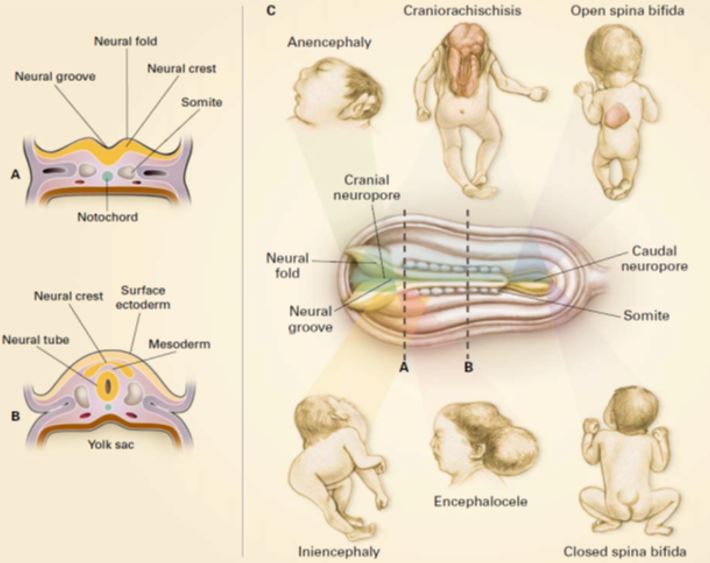Association of NTDs with maternal and only mother serum vitamin B12 Association-A Review Study
Abstract
Neural tube defects (NTDs) are one of the commonest birth defects in our clinical practices. Maternal nutritional factors are associated with increased chance of development of NTDs in offspring. Periconceptional folic acid supplementation can prevent up to three fourths of neural tube defects (NTDs). Some studies reported that there might be an association between maternal serum vitamin B12 levels and NTDs. Dietary vitamin B12 deficiency is a common problem in the Indian subcontinent including Bangladesh because of inadequate dietary intake, dietary habit and/or malabsorption. There is scarcity of study to establish relationship of vitamin B12 and NTDs. It would be beneficial to see the association of vitamin B12 and NTDs in a Bangladeshi population, which may help in deciding about vitamin B12 supplementation as a preventive measure of NTDs.
Downloads
References
2. Rennie, JM (ed.) 2012, Rennie and Roberton’s Textbook of Neonatology, 5th edn, Churchill Livingstone Elsevier, London.
3. Islam, MN, Siddika, M, Bhuiyan, MKJ, & Chowdhury, AM 2013, ‘Pattern of Congenital Anomalies in Newborns in a Tertiary Level Hospital in Bangladesh’, Journal of Surgery Pakistan (International), vol. 18, no. 1, pp. 32-35.
4. Harris, MJ, & Juril, DM 1999, ‘Mini‐review: toward understanding mechanisms of genetic neural tube defects in mice’, Teratology, vol. 60, no. 5, pp. 292‐ 305.
5. Schorah, CJ, Smithells, RW, & Scott J 1980, ‘Vitamin B12 and anencephaly’, Lancet, Vol. 1, no. 8173, pp. 880.
6. Cloherty, JP, Eichenwald, EC, Hansen, AR, & Stark, AR (eds.) 2012, Manual of neonatal care, 7th edn ,Wolter Kluwer & Lippincott Williams and Wilkins, Philadelphia.
7. Botto, LD, Moore, CA, Khoury, NJ, & Ericson, JD 1999 , ‘Neural tube Defects’, The New England Journal of Medicine, vol.341, no. 20, pp 1509
8. Correa, A, Stolley, A & Liu, Y 2000, ‘Prenatal tea consumption and risks of anencephaly and spina bifida’, Annals of Epidemiology, vol. 10, no. 7, pp. 476-77
9. Shaw, GM, Todoroff, K, Vclie, EM, & Lammer, EJ 1998, 'Maternal illness, including fever and medication use as risk factors for neural tube defects', Teratology, vol. 57, no. 1, pp. 1-7.
10. Grewal, J, Carmichael, S, Song, J, & Shaw, GM 2009, ‘Neural tube defects: an analysis of neighborhood and individual level socio-economic characteristics’, Paediatric Perinatal Epidemiology, vol. 23, pp. 116–24.://www.icddrb.org>doc_download>7233-national-micronutriants-status
11. Bound, JP, Harvey, PW, Francis, BJ, Awwad, F & Gatrell, AC 1997, 'Involvement of deprivation and environmental lead in neural tube defects: a matched case-control study', Archives of Disease in Childhood, vol. 76, pp. 107-12.
12. Mc Micheal, AJ, Dreosti, IE, Ryan, F, & Robertson, EF 1994, ‘Neural tube defects and maternal scrum zinc and copper concentrations in mid pregnancy’, The Medical Journal of Australia, vol. 161, no. 8, pp. 478-82.
13. Hinks, LJ, Oglivy-Stuart, A, Hambridge, KM, & Walker, V 1989, ‘Maternal zinc and selenium status in pregnancies with neural tube defects’, BJOG, An International Journal of Obstetrics and Gynaecology, vol. 96, no. 1, pp. 61.
14. Scott, JM 1997,’Bioavailability of vitamin B12’, European Journal of Clinical Nutrition, vol. 51, pp. 49-53.
15. Gibson, RS 2005, ‘Principles of Nutritional Assessment’, 2nd edn, Oxford University Press, New York, NY.
16. Heyssel, RM, Bozian, RC, Darby, WJ, & Bell, MC 1996, ‘Vitamin B12 turnover in man. The assimilation of vitamin B12 from natural food stuff by man and estimates of minimal dailyRequirements’, American Journal of Clinical Nutrition, Vol. 18, pp. 176-184.
17. Refsum, H 2007, ‘Folate, vitamin B12 and homocysteine in relation to birth defects and pregnancy outcome’, British Journal of Nutrition, vol. 854, pp. 109-113.
18. Allen, LH 2009, ‘How common is vitamin B-12 deficiency? American Journal of Clinical Nutrition, vol.89, pp. 693-96.
19. Lee, YK., Kim, HS, & Kang, HJ 2009 ‘Holotransco- balamin as an indicator of vitamin B12 deficiency in gas-trectomized patients’, Annals of Clinical & Laboratory Science, vol.39, pp. 361-366.
20. Iqbal, AS, Shahidullah, M, Islam, MN, Akhter, S, & Banu, S 2001, ‘Serum zinc and copper levels in the maternal blood and cord blood of neonates', Indian Journal of Pediatrics, vol. 68, no. 6, pp. 523-26.
21. Vieira, AR, & Taucher, SC 2005, ‘Maternal age and neural tube defects: evidence for a greater effect in spina bifida than in anencephaly’, Revista Medica de Chile, vol. 133,no.1, pp 62–70.
22. Ratan, SK, Rattan, KN, Pandey, RM.Singhal, S, Kharab, S, Bala, M, Singh, V & Jhanwar, A 2008, ‘Evaluation of the levels of folate, vitamin B12, homocysteine and fluoride in the parents and the affected neonates with neural tube defect and their matched controls’. Pediatric Surgery International, vol. 24, pp. 803-808.
23. Cloherty JP, Eichenwald EC, Stark AR, (eds) 2004, Manual of neonatal care. 5th edn, Lippincott Williams and Wilkins, Philadelphia.
24. ICDDRB, UNICEF, Bangladesh , GAIN ,Institute of Public Health and Nutrition, 2013, National Micronutrients Survey 2011-12, viewed 20 March 2014,http://www.icddrb.org>doc_download>7233-national-micronutriants-status

Copyright (c) 2024 Author (s). Published by Siddharth Health Research and Social Welfare Society

This work is licensed under a Creative Commons Attribution 4.0 International License.


 OAI - Open Archives Initiative
OAI - Open Archives Initiative


